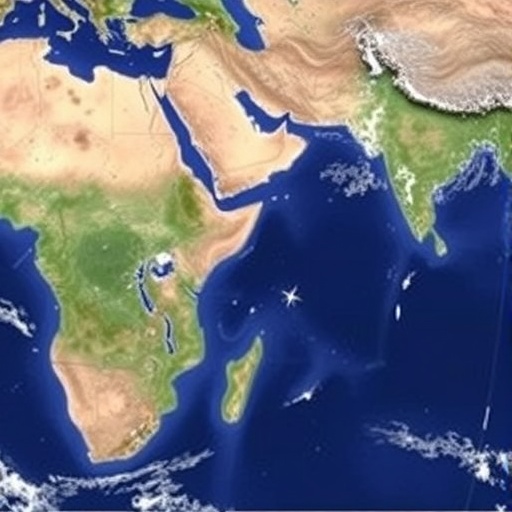Recent advancements in remote sensing technology have significantly influenced how we monitor and assess natural disasters. A groundbreaking study led by researchers Ainscoe, Swaminathan, and Way has emerged, emphasizing the superior capabilities of radar satellites over traditional optical imagery in mapping earthquake damage. This innovative research not only highlights the enhanced accuracy and comprehensiveness provided by radar systems but also presents an opportunity for improved disaster response and recovery planning.
Earthquakes are among the most destructive natural events, causing significant infrastructure damage and loss of life. Effective assessment of the damage following such events is crucial for the timely provision of aid and recovery resources. Traditionally, assessments relied on optical imagery from satellites, which, while useful, has its limitations, particularly under certain atmospheric conditions. The study reveals how radar satellites can overcome these challenges, providing a clearer and more detailed picture of earthquake-affected areas.
The researchers conducted a comparative analysis of the data from radar satellites and traditional optical satellites in the aftermath of a significant earthquake. The findings were striking; radar technology enables sensing through clouds, rain, and even during nighttime. This consistent performance under various weather conditions is critical in regions prone to seismic activity, where timely access to reliable data can directly impact the effectiveness of emergency responses.
In their research, the authors employed advanced synthetic aperture radar (SAR) techniques that allow for high-resolution imaging of the Earth’s surface. SAR captures the reflections of microwave signals emitted towards the ground, which are then processed to create detailed images of the landscape. The resulting data from SAR can effectively highlight changes in the land surface caused by seismic events, such as ground displacement and structural damage.
Ainscoe and his team meticulously studied different urban areas affected by earthquakes. They provided compelling evidence that radar imagery not only captures the extent of the destruction but also reveals subtle deformations in the landscape. These details can help engineers and urban planners assess the structural integrity of buildings and roads, enabling targeted interventions where they are needed most.
Furthermore, the data demonstrates that the analytical capabilities of radar satellites can enhance situational awareness for disaster management agencies. The precision of radar mapping allows for the identification and prioritization of areas that require urgent attention, thereby optimizing resource allocation and response efforts. The implications for humanitarian logistics are profound, particularly in regions with limited infrastructure or accessibility following a disaster.
The study’s authors emphasize that the technology transitions the paradigm of disaster response from reactive to proactive. By utilizing real-time radar data, agencies can better prepare for future earthquakes, implement risk reduction strategies, and enhance community resilience against seismic threats. This proactive approach ultimately reduces vulnerability and enhances safety in disaster-prone areas.
Moreover, the integration of radar satellite data into existing disaster management frameworks represents an exciting frontier in geographic information systems (GIS). The balance between technological innovation and practical application is paramount. As governments and NGOs increasingly turn to digital solutions for disaster preparedness, radar technology can provide the critical insights needed to inform policy and planning.
Collaboration between scientists and policymakers is essential for operationalizing these findings. The engagement of stakeholders ensures that radar imagery is effectively incorporated into disaster management protocols. This integration leads to a more robust understanding of seismic risk and informs engineering practices, ultimately saving lives and infrastructure.
In summary, the study by Ainscoe et al. not only advances our understanding of the potential of radar satellites in disaster response but also paves the way for future research in remote sensing applications. The findings call for a broader adoption of radar technology in monitoring various natural disasters, not just earthquakes. As we continue to face the challenges posed by climate change and natural hazards, embracing innovative solutions like radar imaging could become indispensable in safeguarding populations around the globe.
In conclusion, the implications of this research extend far beyond the immediate benefits of improved damage assessment. The findings represent a significant leap toward harnessing the power of modern technology for better disaster resilience. As we embark on this new chapter in earthquake monitoring, it is essential to recognize the transformative impact of satellite technology in protecting lives and shaping safer, more prepared communities.
While this study sheds light on the effectiveness of radar satellites, it also opens the door for future explorations. Questions remain regarding the potential of integrating radar data with other remote sensing technologies, such as drones and ground-based sensors, maximizing the breadth and depth of analysis available to disaster response teams. The future of disaster readiness lies in such interdisciplinary approaches, combining technological advancements with strategic planning to create a holistic framework for managing natural disasters.
Subject of Research: Earthquake damage assessment using radar satellite technology
Article Title: Earthquake damage mapped more comprehensively and accurately by radar satellites than optical imagery
Article References:
Ainscoe, E.A., Swaminathan, R., Way, L. et al. Earthquake damage mapped more comprehensively and accurately by radar satellites than optical imagery.
Commun Earth Environ 6, 631 (2025). https://doi.org/10.1038/s43247-025-02623-4
Image Credits: AI Generated
DOI: 10.1038/s43247-025-02623-4
Keywords: Earthquake, radar satellites, optical imagery, damage assessment, disaster management, remote sensing




